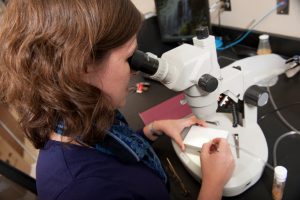By Chris Bryant
Photos by Jeff Hanson

The economy may not be growing quickly, but many of us certainly are. And, we’re not just growing up, we’re growing out.
In 1985, within the nation’s eight known heaviest states, fewer than 14 percent of its citizens were classified as obese. By 2009, all 50 states’ obesity rate exceeded that percentage, and several, including Alabama, exceeded 30 percent.
“We’ve never dealt with being this heavy before,” says Dr. Laura Reed, assistant professor of biological sciences at The University of Alabama. “Within the past 24 years, there has been this dramatic increase.”
As our weights balloon, our health pays a heavy price. About one-third of the people in the United States are classified as having Metabolic Syndrome, Reed says. Originally called Syndrome X, the term Metabolic Syndrome was used as early as the late 1970s, but the term has become more prevalent in the last 10 years.
Metabolic Syndrome is not a disease, Reed says, but rather a collection of symptoms, including abdominal obesity, insulin resistance or full-blown Type II diabetes, and elevated lipid levels (such as cholesterol and other fats) in the blood stream. High blood pressure is often a component.
“It’s predictive of other disease,” says the UA faculty member. “If all of those things are present, the probability that somebody will develop either cardiovascular disease or Type II diabetes is dramatically increased.”
So, why are we getting fatter? The easy answer is we’re eating and stressing more and exercising less. And, while the easy answer certainly contains more than just an element of truth, it’s an oversimplification.
“Some people never get obese,” Reed points out, even when their caloric intake and exercise levels are within ranges that would trigger obesity in others. “Some people never develop Type II diabetes, even if they are obese. What’s going on, genetically,” Reed asks, “to allow that variation in outcome?”
To help her answer just such weighty questions, Reeds turns to what some might consider among the lowliest – not to mention the lightest – of creatures … fruit flies. And, actually, she’s focused on creatures a step lower than the flies – the flies’ maggots.
In a paper published in the July 2010 issue of Genetics, Reed showed that, in the flies, at least, it’s not always about the calories and the activity levels or even the genes, alone. For many, it’s about their specific genetic makeup, or genotype, in combination with the calories consumed.
Reed’s now working, courtesy of a new, $1.4 million National Institutes of Health-grant, to determine which specific genes are at play.
“I will, hopefully, find the actual genes responsible for the natural variation in Metabolic Syndrome, specifically, the genes that interact with the environment to cause some flies to get fat with a high calorie diet while other flies are unaffected by their diets.”

As with mice and other widely accepted animal models used in studying human conditions, many of the biological systems within flies share enough similarities with humans to potentially draw effective insight into human obesity and Metabolic Syndrome, Reed says. For example, flies can contract diabetes and, as they age, heart disease. Their insulin-signaling pathways, key in diabetes, share similarities with those of humans, as do their kidneys, liver and the adipose tissue – the types of tissue where fat is stored.
In the research, in which eight UA undergraduate students participate, the scientists feed the flies four diet types – balanced, calorie restricted, high sugar and high fat. Through inbreeding the flies, Reed has 150 different genetic lines of flies, with every fly in each line genetically identical to the other 50 or so flies in that line. Each line is tested across all four diets.
“We can test every genotype against every environment and actually look at the interaction effect,” Reed says. “In this way, we can disentangle the environmental contributions to body weight, the genetic contribution to body weight and also the interaction between the dietary and genetic contributions to weight.”
After each maggot, or larva as scientists refer to them, nears the end of its larval stage, Reed measures their weights, (even obese fruit fly larvae, if you’re wondering, only weigh slightly more than a milligram) blood sugar and lipid storage levels.
In the research published in Genetics, Reed found that genetics, alone, had a significant impact, as expected, on flies developing Metabolic Syndrome, but, surprisingly, diet, alone, had a relatively small impact. Diet, in combination with specific genetic make-ups, had a much more dramatic impact.
“I was extremely surprised,” Reed says. “I was expecting a much larger diet component. What this means – if we can generalize to humans – is that the weight gain and Metabolic Syndrome in the human population is not just because we’re all eating more calories, but it’s because some particular genotypes are eating more calories. It’s the interaction between particular genetic compositions and our diets.”
This could help explain, Reed says, why anecdotal stories involving fad diets seem to vary so greatly. Some people might lose significant weight on the “grapefruit” diet, for example, while others don’t report close to the same results because they were not “genetically predisposed” to have the same result as the first dieter.
Perhaps, Reed says, science can one day determine which diets are likely to be most effective for which people, based on their genetic make-ups.
“It’s very unlikely that there’s a one size fits all,” Reed says, “although, generally speaking, eating fewer calories and getting more exercise is a good idea.”
In Reed’s NIH project, she’s taking the research to another level. She seeking to understand precisely how genetic variations in the flies result in Metabolic Syndrome by gaining a better understanding of the relevant biological processes.
Think of it, Reed suggests, as trying to understand the key biological mechanisms that occur before someone who is predisposed to cancer actually contracts cancer.
“Not everybody that has a predisposition to cancer gets cancer,” Reed says. “There’s a lot of things that have to happen that determine whether or not they actually get cancer. There are many environmental and developmental processes that influence their ultimate disease state.”

In Reed’s case, she’s seeking an understanding of the processes occurring when differences at the DNA level translates into differences in body weight. Through the study of gene expression – how genes are turned on – and metabolomics – the study of how chemicals in the body, known as metabolites, react to different genetic and environmental conditions – she hopes to further unravel this mystery.
She’s already determined, for example, that glycine, which serves in humans as both a neurotransmitter and an amino acid, is highly correlated with weight, in the flies.
“That gives us some clues about what types of physiological pathways we might expect to be important in determining weight,” Reed says. “How glycine is manufactured in the body, the genes that may be involved in that, the physiological pathways that are involved in that or how it’s digested are all components that may be influencing, ultimately, weight outcome.”
Reed has also identified a second metabolite in the flies that appears to be serving as an endocannabinoid – a type of neurotransmitter that is a component behind the full sensation gained during a meal. This too is a clue, Reed says, that might lead to a more precise genetic understanding of why some people overeat – perhaps they’re missing the signal that provides the full sensation when adequate calories are consumed.
Although Reed’s latest work is in the early stages, it seems evident, she says, the answer to maintaining ideal body weight is not always a simple one.
“This suggests that it is a very complex process in humans.”